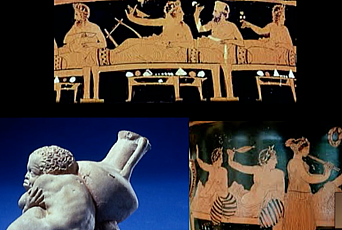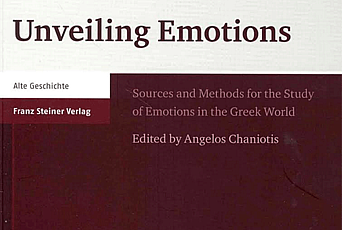A World of Emotions: The Making of an Exhibition
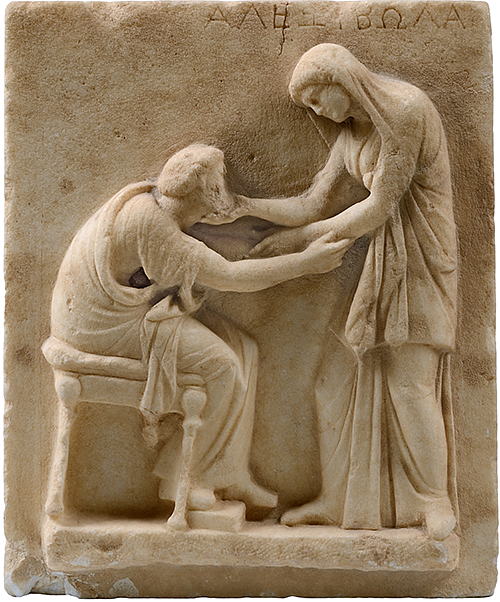
Emotions penetrate every aspect of our lives. Interwoven with memory, attention, cognition, and decision-making, they determine our interpersonal relations, our private life, the public sphere, and religious worship. Emotions are the background of every form of art and literature. In recent years, we have seen how financial crises, corruption, and the failure of political institutions have triggered collective anger in European countries and how fear has influenced the outcome of the Brexit-referendum, the presidential election in the United States, and elections in European Union countries that are confronted with increased numbers of refugees.
To say that emotions matter in historical studies may seem today a trivial observation, but this has not always been the case. For decades, the prevailing trend in historical research was to dissociate emotion and cognition and to ban emotions from historical inquiry. For the greatest part of the twentieth century, influential schools of historical interpretation, such as Marxism and structuralism, preferred to look for laws that determine human life instead of turning their attention to the part played by collective and individual emotions in historical processes. A few years back, I told a prominent German ancient historian that I was working on a research project dedicated to emotions in Greek history, and he expressed his surprise. History, he responded, is the answer to the questions “who,” “when,” “where,” and “why.” Inadvertently, he had offered the most eloquent advocacy for the historical study of emotions. The “whos” of history, the agents and subjects of history, are individuals and groups with feelings; the search for a “why” cannot ignore emotions—if one had doubts about this, then the election of Donald Trump as U.S. president teaches us otherwise; and the “where” and “when,” the contexts of history, always have emotional components. Today, the “history of emotions” is firmly established as a dynamic research area.1
The idea to organize an exhibition dedicated to emotions in Greek antiquity was born in 2013, when my research project “The Social and Cultural Construction of Emotions: The Greek Paradigm” (Oxford, 2009–2013) attracted the interest of Amalia Cosmetatou, Executive Director and Director of Cultural Affairs of the U.S.-based Onassis Foundation. I gladly accepted her invitation to curate an exhibition at the Onassis Center in New York. Two prominent art historians and archaeologists, Nikolaos Kaltsas, Director Emeritus of the Athens National Archaeological Museum, and Ioannis Mylonopoulos, Associate Professor of Ancient Art, Archaeology, and Architecture at Columbia University and former Member (2011-12) in the School of Historical Studies, were invited to join the curatorial team. The concept of the exhibition was jointly developed over the course of two years.
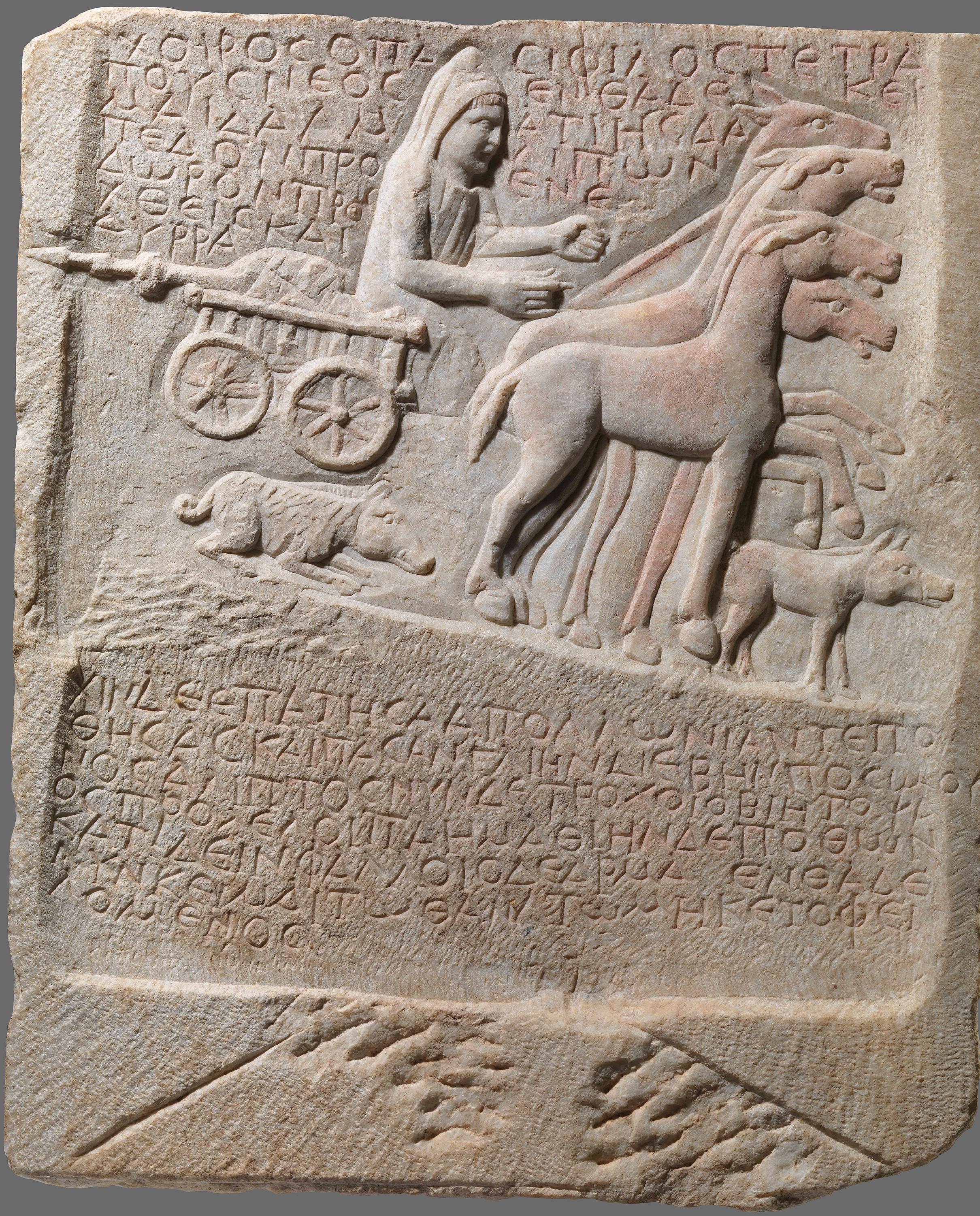
Is there anything special about the ancient Greeks and their emotions? How could one avoid triviality in addressing this subject? Did the death of a beloved person not cause grief among the Greeks as in any other culture? Was economic inequality not the source of envy and hatred, a perceived danger the cause of fear, the birth of a child reason to rejoice, and disappointed love a source of sorrow?
As far as we can see, the basic emotions that we know from our era existed in the Greek world as well: fear and courage, joy and grief, hope and pride, affection and hatred, love and jealousy, desire and disgust, gratitude and envy, contempt, anger, and indignation. An interesting, almost unique, feature of Greek culture is the fact that the Greeks not only personified emotions, but that they worshiped them. Eros is not the personification of erotic desire or a patron god of love; Eros is a god, for whom people set statues and built temples, whom they propitiate, to whom they pray and offer sacrifices. Another important fact is that Greek intellectuals were the first to develop theories of emotion in the West as early as the late fifth century B.C.E.—more or less the same time during which Chinese intellectuals were addressing similar questions in the East. And thirdly, the sociocultural context in which emotions were manifested in ancient Greece was peculiar. Let us take the famous example of the Spartans and their response to fear. The Spartans worshiped the personification of Fear (Phobos) as a god, offering sacrifices; doing this, they hoped that Fear would conquer their enemies. They marched in battle without fear of death. But this proverbial courage does not mean that the feeling of fear was unknown to them. Rather, more than death, they feared their mothers, who gave them shields with the words “it, or on it”—admonishing them either to bring it back or be carried back on it. The way emotions are controlled, expressed, concealed, displayed, performed, described, valued, and aroused depends on social and cultural factors that may range from education and values, religious beliefs and gender, philosophical doctrines and social conventions to legal institutions and economic conditions. For this reason, the manner in which emotions are represented in the source material is influenced by cultural change. Although we can never know what people in the Greek world really felt—there are rare exceptions—we can certainly study the external stimuli that generated emotions. We can also study the cultural and social parameters that determined when and how emotions were manifested in texts. And we can study how emotions are represented in images and other expressions of material culture.
With such considerations in mind, it was decided to organize the exhibition around four general themes: the art of emotions, the spaces of emotions, conflicting emotions, and uncontrolled emotions. The theme “Art of Emotions” confronts the visitor with two questions: What are the means through which ancient artists represented the emotions of gods, mythical heroes, and “real” people? How were images and texts exploited to arouse emotions in an ancient (and modern) audience? Although every exhibit is ultimately related to these questions, a few selected images can show the importance of body language, facial expressions, and composition for the representation and arousal of emotion. The theme “Spaces of Emotions” highlights the importance of emotions in major types of interpersonal relations and social life, and in the main spaces in which emotions are manifested: the family and the group of friends, the public spaces of the city and the battlefield, the sanctuaries and the cemeteries. The last two themes focus on the most complex, darkest, and relevant aspects of emotions. They present mortals, gods, and mythical figures struggling with conflicting emotions such as envy and affection, facing dilemmas, and being dominated by uncontrolled emotions—from erotic passion to hatred and fear.
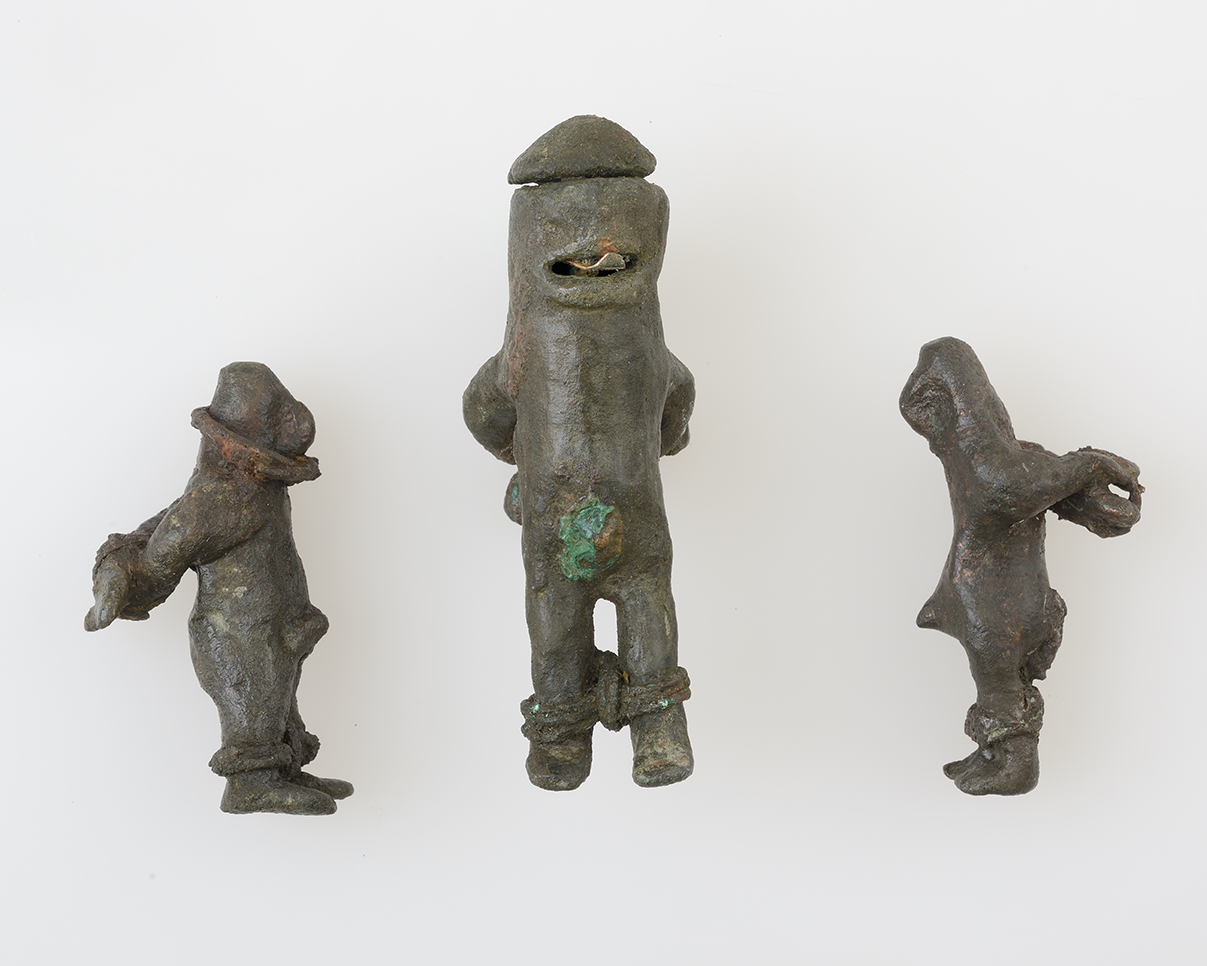
The selection of objects, completed in April 2015, was a very difficult process, certainly not because of lack of abundance. Is there a work of art that is not directly or indirectly connected with emotions, if for no other reason, simply because of an artist’s affectionate dedication to his work? But an exhibition is continually confronted with practical considerations: the budget, the fragile state of some objects, their size and weight, requests by lenders, and problems of transportation and insurance. Other aspects that had to be taken into account include the balanced representation of objects of different provenance, date, material, and type, and the representation of a broad range of emotions and aspects. Some emotions are prominently present in Greek art—joy, fear, grief, anger, and love—and yet others are difficult to detect without knowledge of the context—envy and pride—and still others are hardly ever represented in the material evidence—e.g. disgust. And, of course, a great challenge in such an exhibition is to familiarize a non-specialized audience with the significance of emotions in Greek culture, approximately from Homer to the end of antiquity (ca. 700 B.C.E.–200 C.E.). The list was continually revised, and many (perhaps most) objects on the original wish-lists of the three curators had to be excluded and replaced. But we succeeded in assembling 130 objects, including some masterpieces of Greek sculpture and vase-painting, from twenty-two Greek museums and nine museums in France (Louvre), Germany (Munich), Italy (Naples and Rome), Switzerland (Basel), the United Kingdom (British Museum), the Vatican, and the United States (Boston and the Metropolitan Museum). The exhibits range from life-size statues and grave reliefs to golden grave masks and coins, from magical texts to representations of Greek myths on vases, and from oracular inquiries to theater masks. Diverse artifacts reveal in a paradigmatic way the emotional background of material culture. They range from objects as simple and elementary as a relief plaque that shows the apotropaic symbol of a phallus, threatening intruders, and averting evil, or a cup used for libations to Philia (affectionate friendship) by the participants in a banquet, and the grave inscription for a much loved and talented pig that fell victim to a traffic accident (Figure 2), to artistically sophisticated representations of the emotional interaction between lovers and family members (Figure 1), narrative scenes inspired by complex myths, moving grave inscriptions, curses, and “voodoo-dolls” full of hatred (Figure 3), and oracular inquiries full of worries.
An exhibition requires a narrative; it must tell a story; it must send a message.
The exhibition is conceived as an itinerary that proceeds from the ubiquity of diverse emotions in the ancient world to the impact of strong and uncontrolled emotions. As the visitor moves from one section to the next, another aspect of emotions is revealed, gradually introducing the visitor from simple and familiar facts to more complex and, at times, paradoxical aspects of the emotional lives of the Greeks.
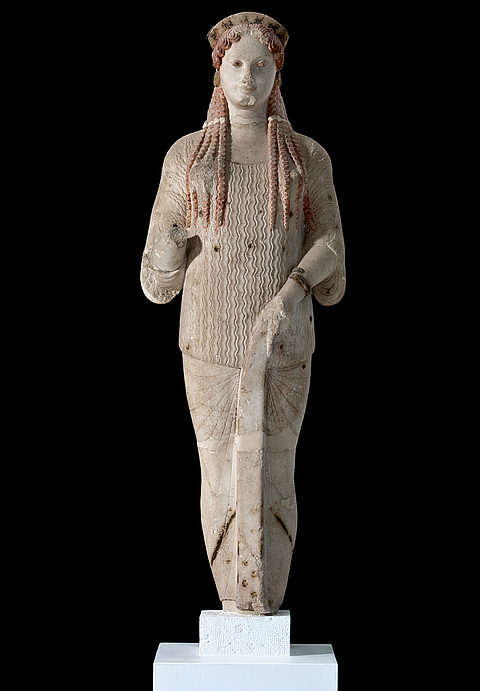
In the organization of the exhibition, the role of the curators resembles that of the scriptwriters of a movie, the exhibition designer relates to the role of the director, and the exhibition managers correspond to the role of the producers. The scriptwriters tell a story, the director presents it visually, and the producers make sure that this all happens in such a way that the audience comes to the theater, leaves it satisfied, and the critics write good reviews. The final design of this exhibition is the product of a close collaboration between the three curators, who were assisted by Mimika Giannopoulou, the very experienced exhibition designer Daniel Kershaw, Amalia Cosmetatou, who directed the entire operation, and Roberta Casagrande-Kim, who was charged with exhibition management.
So, let us start with the story. The “story” or narrative of this exhibition is indicated by its title: Greece Is a World of Emotions. The Greeks told myths, wrote literature, performed tragedies, and made art because they were driven by emotions, because they expressed emotions, and because they wanted to arouse emotions. The Iliad, the earliest work of Greek literature—traditionally dated to ca. 700 B.C.E. or a few decades later—narrates a dramatic episode of the Trojan War. The poem’s very first word, the very first word of European literature, is an emotional term: menis, “wrath.” “Sing to me of the wrath of Achilles” is the poet’s appeal to the Muse. The subject of the Iliad is not a war, as we often think, but an emotion: Achilles’s indignation, caused by an insult. The Iliad begins by explaining the cause of the wrath, describes its manifestations and consequences—Achilles’s retreat from battle and the death of his friend Patroclus—continues with Achilles’s return to combat, the killing of Hector, whose corpse is dragged behind Achilles’s chariot, and finds closure in the mourning of Achaeans and Trojans for their fallen heroes Patroclus and Hector. Emotions dominate also the second early epic, the Odyssey: its main subject is Odysseus’s desire to return home (nostos). It is also the narrative of the loyal affection shown to Odysseus by his wife, his son, his slaves, and his dog. From its very beginning, Greek literature made emotions the center of its observation and treatment. While the rhapsodes were singing of the emotions of past heroes, Archilochos, a Parian poet of the mid-seventh century B.C.E., was singing about his own emotions: affectionate friendship, love, hatred because of betrayal, fear of death, and courage. He is the first poet who addresses his soul (thymos), urging himself to take joy and bear grief with measure, and to be stronger than hope and fear. The lyric poets of the next generation were quick to follow, and Sappho was honored as the “tenth Muse” for a love poetry that still gets under our skin.
Emotions shaped Greek culture no less than reason. This is a simple and straightforward message. But, still, the story is full of tensions, contrasts, contradictions, and conflicts. There are many ways to tell this story, but an exhibition must choose one, otherwise it will confuse the visitor; it will be incoherent and unclear. And although the visitors may want to see something twice or may want to spend more time in front of an object than another, nevertheless, they should be gently guided from one theme to the next. This exhibition does not require any pre-existing knowledge. For this reason, a meaningful itinerary had to proceed from simple and familiar images to the more complex, shocking, and puzzling.
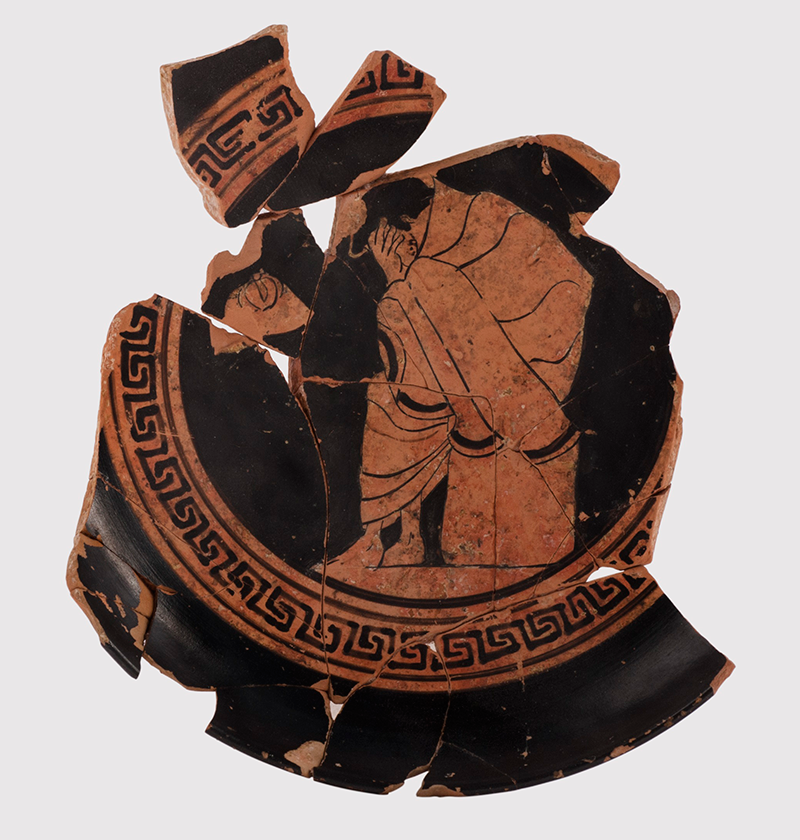
Our itinerary starts in the sheltered domestic space, and roughly follows a lifecycle. It begins with birth and childhood, with harmony and peace, and gradually proceeds from inside to outside, from harmony to conflict, from light to darkness, from life to death, from reason and order to a lack of control. The first images show mothers who tenderly hold their children in their arms; the last images show mothers who kill their children driven by emotion. According to this concept, the natural movement is from the house to the sanctuary, the cemetery, the public space, and the battlefield. From the real life experiences of the ordinary mortals, the exhibition gradually moves to the larger-than-life experiences of heroes and gods. As with any good story, the exhibition must have an apex, so that when the visitors reach the end they feel—as in Aristotle’s famous definition of tragedy—catharsis through fear and empathy. The climactic point is the last section, which is dedicated to uncontrolled emotions and proceeds from the impact of intense erotic desire to the results of hatred, rage, and jealousy. The last image that the visitors see on a projection wall is the image of Maria Callas rehearsing for her title role in Cherubini's Medea at Content Garden in 1959. Exiting the exhibition from the lower level of the Olympic Tower, they ascend a staircase, thus moving from the past to the present, from darkness to light, from emotion to cognition.
At the entrance of the exhibition, the visitor is greeted by two Archaic life-size statues of a young man (a kouros) and a maiden from the Acropolis (kore) (Figure 4); their faces wear the Archaic smile, whose interpretation is ambiguous: joy, pride, delight, or a vague expression of life? The visitor is also confronted with a “wall” of sculpted faces, roughly in a chronological arrangement from the sixth century B.C.E. to the early third century C.E. These faces, as well as examples of vase-painting (Figure 5), exemplify the physical manifestation of emotions through facial appearance and body language. Behind the two statues and the wall, the visitor recognizes two statues that dominate the central space of the exhibition: the statue of Pothos, the personification of Longing and Desire (Musei Capitolini in Rome), and the statue of Eros from the Louvre, who playfully shoots his arrows, arousing erotic desire in gods and mortals.
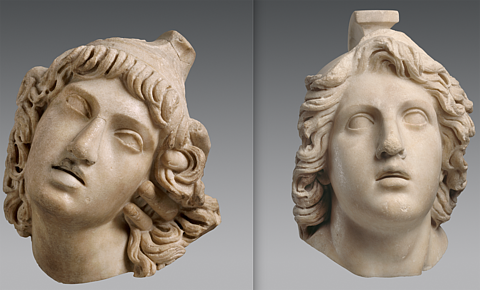
The visitors then move from right to left, examining manifestations of emotions in the domestic space (affection between parents and children, children and animals, lovers, joy in banquets), the sanctuary (gratitude and hope in the relations between mortals and gods), the cemetery (grief and hope for afterlife), the public space (gratitude for benefactors, hatred against political enemies), and the battlefield (rage, pride for victory). The battlefield confronts the visitor with violence and conflict, two predominant themes in the following sections of the exhibition. A fresco from Pompeii, depicting the sacrifice of Iphigeneia, dominates the main wall of the exhibition and a section dedicated to emotional conflicts. Other important exhibits are representations of the particularly moving myth of Achilles and Penthesileia, the Amazon queen (Figure 6). The hero slays the Amazon but when he removes her helmet and sees her dying face, he falls in love with her.
From emotional conflicts, the visitor then moves to actions driven by uncontrolled emotions: desire, rage, hatred, jealousy, and fear. This section assembles both artifacts of everyday life—curse tablets against enemies and apotropaic symbols—and representations inspired by myth, including strong images of erotic desire—Zeus approaching Leda in the guise of a swan (Figure 7) and abducting Ganymede in the guise of an eagle—and shocking images of uncontrolled rage. The last displays highlight one of the most shocking ancient myths of uncontrolled emotions, the myth of Medea. Driven by her love for Jason, she dismembered her own brother; later, abandoned by Jason and driven by jealousy and indignation, she took revenge on him by killing not only his new wife but also her own children.
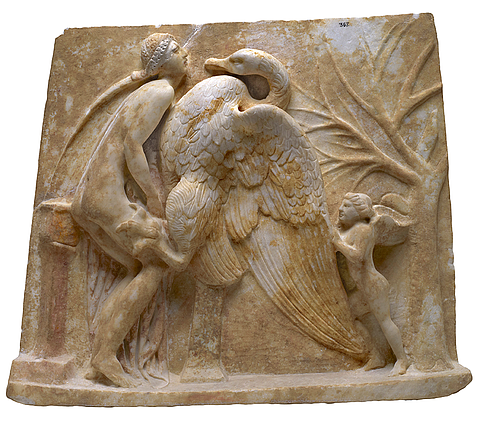
There are good reasons why the emotions of the Greeks matter today. First, because of the exceptionally good source material, consisting of literary texts, scientific and philosophical treatises, inscriptions, papyri, and works of art, we can study in a paradigmatic way the factors that determine the manifestation of emotions in a primarily urban and literate culture for a millennium, from the time of the first recorded literary texts to the establishment of Christianity. Secondly, emotions have shaped all the sources that we have at our disposal, from the verses of a great potter to the image of a humble painter who shows a satyr tenderly holding an infant satyr in his arms (Figure 8).
We do not study Greek texts and works of art in order to understand emotions. We study emotions in order to be able to understand fully the texts and works of art that Greek culture produced. Our perception of classical Greek antiquity is dominated by an interest in its rational aspects. We tend to understand the development of Greek culture as a movement from myth to reason, focusing on achievements that were based on objective observation and cognition. This approach is not wrong, but it is incomplete. From the very first word of Greek (and European) literature—menis, “wrath”—to the coming of Christianity, we observe the presence of emotions in every expression of Greek history, culture, institution, and society.
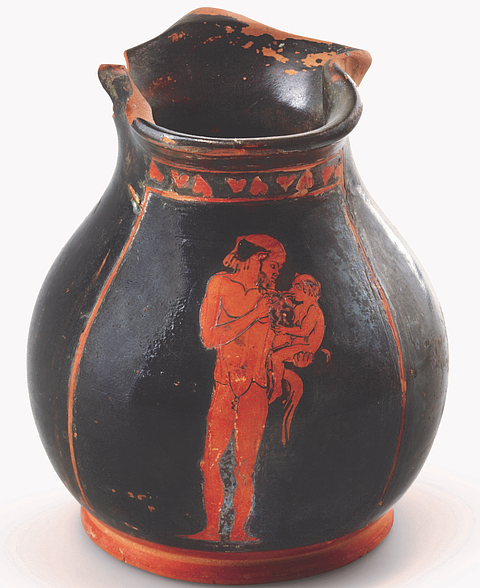
Thirdly, Greek art and literature, transmitted through the centuries, incorporated into education, and elevated into the status of “classic,” have confronted men and women of any time and culture with fundamental problems of human nature, archetypal emotional conflicts, and recurring behavioral patterns. Let us take the passions of larger-than-life figures such as Medea, whose emotional conflicts have influenced world literature. Performed time and again and included in canons of literary texts, Greek tragedies, such as Euripides’s Medea, became part of the world’s cultural heritage, transcending the borders of time, language, and culture. It inspired six operas between 1649 and 1797 alone—the best known being Luigi Cherubini’s Medea of 1797.2 The most impressive staging of Euripides’ Medea is a 1984 cross-cultural version of the Greek poet’s innovative treatment of the themes of love, betrayal, jealousy, anger, and revenge: the work of the Japanese director Yukio Ninagawa. In one of the most memorable scenes of world theater—projected in a tablet in the exhibition—Medea, played by the actor Mikijiro Hira, renounces her love by endlessly pulling a red ribbon out of her mouth.3
Hopefully, this exhibition will trigger thoughts about the importance of emotions in our world and show why the study of emotions in classical antiquity may help us better understand the contemporary social and cultural environment. We may often be puzzled by emotions, but we cannot ignore them.
Recommended Viewing and Reading: The exhibition “A World of Emotions: Greece, 700 BC–200 A.D.,” curated by Angelos Chaniotis, Nikolaos Kaltsas, and Ioannis Mylonopoulos, and designed by Daniel Kershaw, is on view at the Onassis Cultural Center New York from March 9 to June 24. The exhibition is free and open to the public. Additional information is available at http://onassisusa.org/exhibitions/a-world-of-emotions.
“‘A World of Emotions’ in Greek Art Unmasks the Stony Faces” by Holland Cotter, New York Times, March 23, 2017, http://nyti.ms/2pAP3Gu
1 For recent overviews, see J. Plamper, The History of Emotions: An Introduction, Oxford, 2015; R. Schnell, Haben Gefühle eine Geschichte? Aporien einer History of Emotions, Göttingen, 2015.
2 Giasone by Francesco Cavalli (1649), Thésée by Jean-Baptiste Lully (1674), Médée by Marc-Antoine Charpentier (1693), Teseo by Georg Friedrich Händel (1713), Medea by Georg Anton Benda (1775), and Medea by Luigi Cherubini (1797).
3 M. Smethurst, Ninagawa’s Production of Euripides’ Medea, American Journal of Philology 123, 2002, 1–34.
